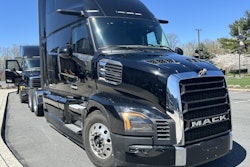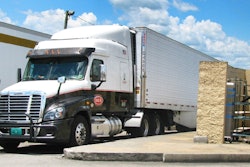
As the industry grapples with market instability, managing risks and adapting to economic shocks is essential to operate efficiently.
Uncertainty has caused fleets to “tighten everything up,” Karol Smith, director of transport compliance at Estes Forwarding, said during a panel last week at Motive’s annual summit Vision 25 held in Austin.
Smith, who manages about 90 fleets, said they’re “watching every penny we’re spending.” This includes examining the most efficient freight routes and utilizing software like Motive to observe fuel spend, as well as implementing geofencing to identify workforce productivity.
Hamish Woodrow, director of strategic analytics at Motive, said what they see on the customer side that seems to be effective is diversification of income streams.
“There’s going to be a lot of disruption at different ports, and I think, really looking at short-term disruptions, we already see it,” said Woodrow, who added they have seen about a 49% year-over-year increase in traffic in the port of Laredo. “There’s huge opportunities available, but there’s also going to be areas that are going to be impacted.”
As tariff uncertainty dents trade volumes, analysts reduced the 2025 outlook for the U.S. ports sector from “stable” to “negative,” according to a study from Moody’s. Preliminary estimates suggest that cargo volumes in 2025 will decline between the 7% and 12% range due to the surge of import tariffs, as well as counter-tariffs imposed by countries globally on U.S. imports that will affect U.S. export trade volumes.
“There’s a lot of uncertainty there in the decision making, and so there’s risk aversion happening,” Woodrow said. “I think we’ll see that start to happen in inventories over the course of the year or so, depending on how consumer sentiment stays and how bullish or bearish people are going to be when it comes to buying or bringing inventory into the country.”
Using technology to stay agile
Besides resilience and diversification, Woodrow noted that another critical factor is visibility, especially as the trucking industry is experiencing one of the worst recessions on record.
“It has been exceptionally difficult, but it’s forced everybody to get very granular on your costs,” he said, adding that the market will rebound and those who can maintain tight cost controls and continue to capture every bit of margin will be in a strong position.
Technology plays a huge role in this, Woodrow said, as it provides the visibility needed to understand exactly where the money is going, helping to build a more resilient business.
“History teaches us that some of the biggest businesses will grow during this period as well. There will be mid-market businesses that go into enterprise leads,” Woodrow said.
The real opportunity, he added, lies with those who can keep costs low while diversifying revenue streams and building a sustainable, agile business model.
Jim Olson, former vice president of safety for Republic Services, encouraged benchmarking to analyze key metrics and gain valuable insights. He also encouraged involvement with associations because the connections gained are priceless.
“The relationships can help you bridge your gaps and build with everything,” he said.
Another issue that Smith said has been tough in the current economy is finding the right driver you want to run your fleet. He said Estes uses multiple platforms and a recruiting team to help narrow down qualified drivers.
“It’s (about) getting that driver’s attention; what do you have to offer that driver? What is going to attract that driver to come to you?" he said.
Olson said Republic partnered with a CDL training school to target young people looking for a career, either to become a technician or a driver. A huge game changer, he said, was noticing how certain markets in the country don’t have issues finding drivers, while in other markets, they can’t find them at all.
Olson noted that though analytics and tools can help drivers change their behavior, it doesn’t replace one-on-one conversations.
“I’m a huge advocate for supervisors to do ride-alongs with drivers and spend time with them on their route and have conversations with them because that builds relationships,” he said.












